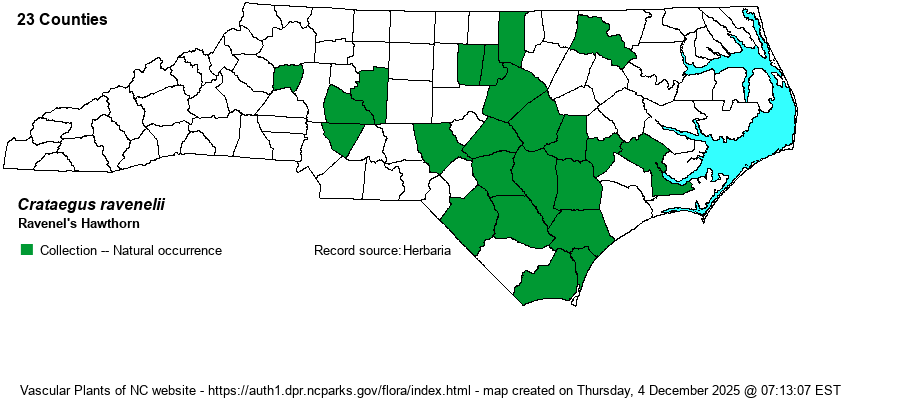| Section 6 » Family Rosaceae |
Show/Hide Synonym
| taxonName | relationship | relatedTaxonName | relatedTaxonRefText | relComments |
|---|
|
| Crataegus ravenelii | = | Crataegus condigna | Flora of North America (1993b, 1997, 2000, 2002a, 2002b, 2003a, 2004b, 2005, 2006a, 2006b, 2006c, 2007a, 2009, 2010) | | | Crataegus ravenelii | > | Crataegus condigna | Flora of North America (1993b, 1997, 2000, 2002a, 2002b, 2003a, 2004b, 2005, 2006a, 2006b, 2006c, 2007a, 2009, 2010) | | | Crataegus ravenelii | > | Crataegus condigna | Kalkman in Kubitzki (2004). | | | Crataegus ravenelii | > | Crataegus condigna | | | | Crataegus ravenelii | < | Crataegus flava | Kartesz (1999) | | | Crataegus ravenelii | < | Crataegus flava | Radford, Ahles, and Bell (1968) | | | Crataegus ravenelii | < | Crataegus flava | Small (1933, 1938) | | | Crataegus ravenelii | > | Crataegus adunca | Kalkman in Kubitzki (2004). | | | Crataegus ravenelii | > | Crataegus clara | Kalkman in Kubitzki (2004). | | | Crataegus ravenelii | > | Crataegus compitalis | Kalkman in Kubitzki (2004). | | | Crataegus ravenelii | > | Crataegus pulla | Kalkman in Kubitzki (2004). | | | Crataegus ravenelii | > | Crataegus ravenelii | Kalkman in Kubitzki (2004). | | | Source: Weakley's Flora |
|
| Author | Sargent | |
| Distribution | Occurs over the Coastal Plain and Piedmont to an undetermined extent, though seemingly more widespread in the southern Coastal Plain than elsewhere. Details of the range are not well known. In fact, owing to an unsettled taxonomy, no herbarium contains NC specimens under the name of Crataegus ravenelii yet. However, it appears that the majority of the Coastal Plain and Piedmont records of the former C. flava, which has been split up into a handful of species, now refer to this species (and not yet split out by most herbaria). Coding nearly all former C. flava records for these two provinces as the "new" C. ravenelii is certainly dangerous, but even if some of the counties on the map presumably do not refer to C. ravenelii, the website editors do not want to toss out nearly all records of C. flava, especially in the Piedmont. However, the range map below should be generally correct.
A Southern species, ranging north to central and eastern NC and south to northern FL and much of AL (Weakley 2018). It is not yet known, apparently, from VA. | |
| Abundance | Uncommon to fairly common, at least in the southern Coastal Plain; however, likely to be rare to uncommon in the Piedmont and in the central Coastal Plain. Weakley's (2018) map indicates it as "common" in the Coastal Plain and "uncommon" in the Piedmont. Lance (2014) calls it "uncommon" but as a variety of C. alabamensis. As the NC NHP does not have this species in its database, this website has given it an S4? state rank, based mainly on Weakley's giving a "common" abundance to the Coastal Plain. | |
| Habitat | As with most Coastal Plain hawthorns, it occurs in sandy or dry soil of pine-oak forests, edges, and thickets; it may also occur in rocky sites. Details of habitat do not seem to be clear in NC. |
| Phenology | Blooms in April, and fruits in August and September. | |
| Identification | This is a usually a small tree, to about 12-20 feet tall, with a fairly broad trunk. Like many other hawthorns, it has a fan- or wedge-shaped leaf, strongly tapering to a long and narrow base, often with a moderately long petiole. The outer half of the leaf is usually strongly serrated but not deeply cut, and thus there are usually no lobes. The leaves when young are quite pubescent/hairy, but they become glabrous as they age. The inflorescences are tomentose. Though almost certainly not a scarce species in the southeastern part of the state, most people are not likely familiar with this newly “named” species and thus will likely have to key out any and all hawthorns they see with wedge-shaped or fan-shaped leaves; there are quite a few such species in this part of the state! | |
| Taxonomic Comments | C. ravenelii was originally described in 1902, but as with most such hawthorns described more than a century ago, most references in the latter half of the 20th Century lumped the majority within C. flabellata, C. flava, or a handful of other widespread species, not believing there were really 200 or more hawthorn species in eastern North America, and/or were not willing to deal with such a number of “species”. C. ravenelii was not mentioned in RAB (1968), though Weakley (2018) implied that RAB included it within C. flava. Interestingly, Lance (2014) recently named it as simply a variety of C. alabamensis – i.e., C. alabamensis var. ravenelii. However, Weakley (2018) and some others have maintained C. ravenelii as a good species. NatureServe does not yet include it in its flora. Needless to say, there is still much controversy whether this is a good species or not.
| |
| Other Common Name(s) | None | |
| State Rank | [S4?] | |
| Global Rank | GNA | |
| State Status | | |
| US Status | | |
| USACE-agcp | | |
| USACE-emp | | |

